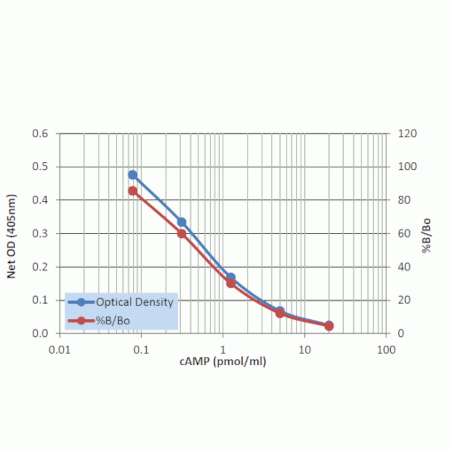Highly sensitive with an optional acetylation protocol which increases sensitivity >10-fold
High throughput format, results for up to 39 samples in duplicate in just 3 hours
Flexible assay, species independent
Easy-to-use pre-coated plate and liquid color-coded reagents reduce errors
Efficient and well-established sample handling protocols
Widely cited in peer-reviewed publications
This is a colorimetric competitive immunoassay kit for the quantitative determination of intracellular cAMP in cells or tissues lysed in 0.1 M HCl, which is used to stop endogenous phosphodiesterase activity and stabilize the released cyclic AMP. The 0.1M HCl treated samples are then analyzed directly in a microtiter plate without extraction, drying and reconstitution. Sensitivity is increased >10-fold by acetylation (reagents included). Absorbance is read at 405 nm. The large signal-to-background ratio offers superior sensitivity compared to competitors. This kit lets you easily assess adenylyl cyclase activation by GPCRs.

Typical standard curve used to calculate cAMP concentrations for Acetylated assay format.
Please mouse over


Product Details
| Alternative Name: | cyclic AMP |
|
| Sensitivity: | Non-acetylated: 1.18 pmol/ml (range 0.78 - 200 pmol/ml)
Acetylated: 0.006 pmol/ml (range 0.078 - 20 pmol/ml) |
|
| Assay Time: | 3 hours |
|
| Applications: | ELISA, Colorimetric detection
|
|
| Application Notes: | For the quantitative determination of cAMP in cell lysates and tissue from any species. Cited sample types include tissue culture. |
|
| Wavelength: | 405 nm |
|
| Species reactivity: | Species independent
|
|
| Crossreactivity: | cyclic AMP (100%)
AMP, ATP, cyclic GMP, GMP, GTP, cyclic UMP, CTP (<0.001%) |
|
| Use/Stability: | Store all components at +4°C, except standard and conjugate at -20°C. |
|
| Shipping: | Shipped on Blue Ice |
|
| Contents: | GxR IgG Microtiter plate, Conjugate, Antibody, 0.1M HCl, Neutralizing reagent, Wash buffer concentrate, Standard, pNpp Substrate, Stop solution, Acetic anhydride, Triethylamine |
|
| Scientific Background: | Cyclic AMP (cAMP) is one of the most important “second messengers" involved as a modulator of physiological processes. A number of hormones are known to activate cAMP through the action of the enzyme Adenylate cyclase which converts ATP to cAMP. cAMP has been shown to be involved in the cardiovascular and nervous systems, immune mechanisms, cell growth and differentiation, and general metabolism. |
|
| Regulatory Status: | RUO - Research Use Only |
|
| Compatibility: | This product is compatible with the Absorbance 96 Plate Reader.
 |
|
Product Literature References
Cyclic AMP-binding protein Epac1 acts as a metabolic sensor to promote cardiomyocyte lipotoxicity: M. Laudette, et al.; Cell Death Dis. 12, 4149 (2021), Abstract;
Exendin-4 stimulates autophagy in pancreatic β-cells via the RAPGEF/EPAC-Ca2+-PPP3/calcineurin-TFEB axis: F.P. Zummo, et al.; Autophagy (2021), Abstract;
Exhaustive endurance exercise activates brain glycogen breakdown and lactate production more than insulin-induced hypoglycemia: T. Matsui, et al.; Am. J. Physiol. Regul. Integr. Comp. Physiol. 320, 500 (2021), Abstract;
Functional evidence for biased inhibition of G protein signaling by YM-254890 in human coronary artery endothelial cells: Q. Peng, et al. ; Eur. J. Pharmacol. 891, 173706 (2021), Application(s): Intra-cellular cAMP level with human coronary artery endothelial cells (HCAEC), Abstract;
Glucagon transiently stimulates mTORC1 by activation of an EPAC/Rap1 signaling axis: S. Sunilkumar, et al.; Cell. Signal. 84, 110010 (2021), Abstract;
Inhibition of PDE4 by apremilast attenuates skin fibrosis through directly suppressing activation of M1 and T cells: Q. Lu, et al.; Acta Pharmacol. Sinica (2021), Abstract;
Pre-clinical evaluation of dual targeting of the GPCRs CaSR and V2R as therapeutic strategy for autosomal dominant polycystic kidney disease: A. Di Mise, et al.; FASEB J. 35, 21874 (2021), Abstract;
Rescue of cell surface expression and signalling of mutant follicle-stimulating hormone receptors: H. Sharika, et al.; Endocrinology (2021), Abstract;
The level of secondary messengers and the redox state of NAD+/NADH are associated with sperm quality in infertility: S.N. Galimov, et al.; J. Reprod. Immunol. 148, 103383 (2021), Abstract;



